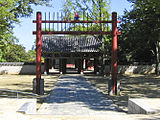Hongsalmun
| Hongsalmun | |
 The hongsalmun at the lleung Royal Tomb (Joseon dynasty royal tombs) | |
| Korean name | |
|---|---|
| Hangul | 홍살문 |
| Hanja | |
| Revised Romanization | Hongsalmun |
| McCune–Reischauer | Hongsalmun |
In architecture, a hongsalmun is a gate for entering a sacred place in Korea.[1][2] Hongsalmun, also called hongjeonmun or hongmun,[3] are usually erected to indicate Korean Confucian sites, such as shrines, tombs, and academies such as hyanggyo and seowon.[1] The gate indicates entry to a sacred realm.[4]
Features
[edit]Hongsalmun literally means ‘gate with red arrows’, referring to the set of pointed spikes on its top. In the past, spikes in between columns did not exist. The color is said to be red because of the belief that the color repels ghosts.[5] The gate is composed of two round poles set vertically and two transverse bars.[1] These pillars are usually over nine meters in height.[3] There is no roof and no door-gate. In the middle top gate the symbol of the trident and the taegeuk image are placed.[1]
The hongsalmun gate opens to a path that leads toward the front of hyanggyo and the hamabi or the "memorial dismount stone".[3][6] The gate can also be found inside a seowon,[7] a privately owned complex that served as a Confucian shrine and preparatory school.
Gallery
[edit]-
The hongsalmun at the shrine of the clan Yi of Jeonju
-
The hongsalmun at the lleung Royal Tomb (Joseon dynasty royal tombs)
See also
[edit]- Iljumun, religious portal
- Torana, a type of Hindu-Buddhist gate
- Torii, in Japanese temple architecture
- Paifang, in Chinese temple architecture
- Tam quan, in Vietnamese temple and pagoda architecture
References
[edit]- ^ a b c d An Illustrated Guide to Korean Culture - 233 traditional key words. Seoul: Hakgojae Publishing Co. 2002. pp. 186–87. ISBN 9788985846981.
- ^ "A Trip to Royal Tombs of the Joseon Dynasty". visitkorea. Archived from the original on February 4, 2014. Retrieved June 12, 2010.
- ^ a b c Choi, Wan Gee (2006). The Traditional Education of Korea. Ewha Womans University Press. ISBN 978-89-7300-675-5.
- ^ Jo, Myeong-hwa (2014-05-07). 1 Course Joseon Royal Tombs : Seonjeongneung (in Korean). 테마여행신문 TTN Theme Travel News Korea. ISBN 979-11-951699-5-5.
- ^ Koehler, Ben Jackson and Robert (2015). Korean Architecture: Breathing with Nature. Seoul Selection. ISBN 978-1-62412-047-3.
- ^ Lee, Sang-hae; Yi, Sang-hae (2005). Seowon: The Architecture of Korea's Private Academies. Seoul: Hollym. p. 72. ISBN 978-1-56591-218-2.
- ^ Urimunhwa December 2020. 한국문화원연합회. 2020. p. 16.


